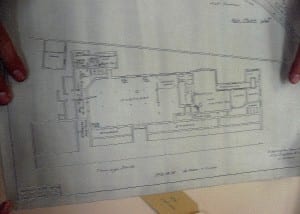It was mentioned that the Lincoln Grandstand may have been used as a mortuary during WWII, during a visit to the archives I took this picture of a map of the place. It’s not very clear but it is certainly clear enough that when you look at it you can see the word PLAN in capital letters at the bottom of the page.
The friendly gentleman who was introducing all the information on the grandstand explained that it is unknown whether the grandstand ever was used as a mortuary and all the evidence we have of that is the map in the picture that clearly says PLAN.
The council, I imagine, would have put the plan in place as a precaution. If the bombing in Lincolnshire got so bad, the grandstand would be an ideal place to keep the dead – after all, what else would it be doing?
Town Halls, schools, drained out swimming pools, gymnasiums… all examples of the kind of place where you could find a make shift mortuary during WWII.
Now, we know that during WWI much of the West Common was used to test aircrafts and as a location for training men to dig trenches. But what do we know of the West Common in WWII, I myself know nothing, and this is not through lack of looking it is merely through not finding anything.
Perhaps I am too fixated with the issue that it is not a known fact that the grandstand was used as a mortuary. The only evidence is a precautionary map and I think it is foolish to allow oneself to be overcome with a chill of what it could have been – the idea that had it have been a mortuary, it wouldn’t be used today as a community centre where children play or used as a makeshift mosque; that it would be more neglected than ever and wouldn’t be a place for anybody except ghosts.
All this being said I appreciate the idea of site specific performance being “a balance between ‘the host and the ghost’”. (Mike Pearson and Michael Shanks quoted in Govan). I understand that we must take into consideration the history of the grandstand when creating a piece that reflects it, but the mortuary is an assumed past – we do not know it to be true, therefore is it right in supporting Govan’s thoughts in that “fiction and fact are shown to be equally unreliable and the notion of history as a stable entity is banished.” The past of the grandstand is that it Could have been used as a mortuary, but this capitalised Could is what is blurring the line between fact and fiction.
References
Govan, Emma (2007) Making a Performance. Coxon: Routledge

